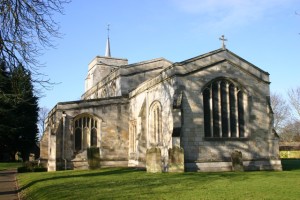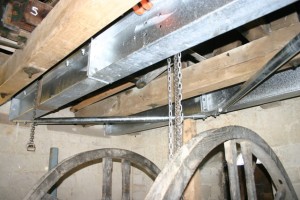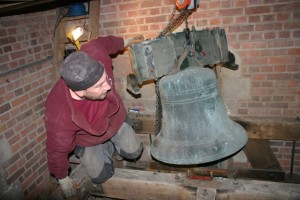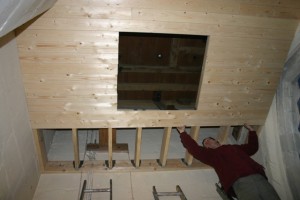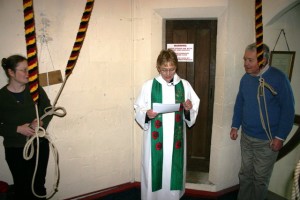The Grade 1 Listed Church of St Mary the Virgin, Eaton Bray, Bedfordshire, contains a ring of 6 bells which have long been notorious as awkward to ring. This was hardly a problem for many years during which the Church did not have a regular band of ringers and the bells were only rung very infrequently for weddings or the occasional service, when it was necessary to import ringers from other local towers.
However, with the setting up of the Association of Ringing Teachers’ Accredited Teaching Centre at nearby Marsworth, in Buckinghamshire, a number of members of the substantial Eaton Bray congregation expressed an interest in learning to ring. They were duly taught at Marsworth, following the “Learning the Ropes” scheme, and by Christmas 2013 regular Sunday Service ringing at Eaton Bray, albeit rounds only at first, became the norm. But the bells’ notoriety was not conducive to ringing by a largely inexperienced team, as well as developing some unhelpful handling habits, and in fact seemed to become more difficult as time went on. Something needed to be done!
Before going into the details, it is first useful to understand the unusual circumstances at Eaton Bray. “The Church Bells of Bedfordshire” records that Eaton Bray had a ring of 5 bells by at least 1790, when the old John Briant tenor was cast, although the 2nd and 4th were dated 1656 so the old tenor was probably recast from an earlier bell. Judging by the size of the old tenor, its weight must have been around 15cwt, and it is difficult now to imagine how such a small tower, only 9ft 6ins square internally, could have housed such a heavy ring.
However, even by 1881 it is noted that the bells had been silent for some years and that the tower was in a dilapidated condition, although at that time the rest of the Church was being restored. Some 30 years later, the tower was at last rebuilt and in 1913 Thomas Bond of Burford was contracted to rehang the bells and augment them to 6. In fact, the old 4th and 5th were recast into the present front three bells, the original front 3 of the 5 becoming the back 3 of the new ring. The 6 bells are accommodated on a two-tier frame, the lower level containing the front 3 bells, together with the clock mechanism, and the upper tier containing the back 3 bells and Sanctus bell.
The frames are built in oak (unlike many Thomas Bond frames which are apparently made from pitch pine) and appear to be quite well made and are in very good condition showing little, if any, signs of ageing. The upper frame shows considerable signs of modification; it is unclear whether this implies that part of the old frame was incorporated or it was found necessary to undertake major modification to the frame in order to fit everything in, since the modified sections do not show any obvious signs of being older than the rest. However, the major problem with the frame was that it was inconsequentially supported. Indeed, during the strengthening work which is described later it became clear that one of the main supporting beams for the lower frame was loose and nothing was actually resting on it! Also one of the beams supporting the upper frame had been cut in order to hang the Sanctus bell, and was merely resting on a quite insubstantial timber which in turn was just resting on stone corbels set in the wall!
The only known subsequent work on the bells was when they were rehung on Mears & Stainbank roller bearings instead of the original plain bearings. Whether this work was done by Whitechapel and when does not appear to be recorded, but Whitechapel advise that it must have been pre-1945. Presumably, at the same time, the ringing circle was modified by the addition of pulleys high up in the ringing room, with the ropes drawn across at a sharp angle, to bring the ropes away from the wall. Unfortunately this simply added to the difficulty of ringing the bells.
We shall now fast forward to February 2014. It was decided to request Taylor’s of Loughborough to visit Eaton Bray to investigate the poor “go” of the bells and to advise how this may be remedied. It needed to be realised from the outset that, although the bell ringing was very much appreciated and valued by the Vicar and congregation – who had been known to applaud the ringers on emerging from the tower – there was already a major fund raising effort in progress towards provision of much-needed toilet and kitchen facilities. Therefore a complete rehang, however desirable that may have been as the ultimate solution, was clearly out of the question.
Investigation by Peter Hayward revealed, as suspected, that during ringing there was considerable movement of the bell frames due to their inadequate support. Also it was felt that the roping down of the bells left a lot to be desired, not just due to the pulleys but also the excessive draught of the 2nd & 3rd bells. An initial quote was prepared for inserting heavy duty steel beams into the tower to support the bell frames, together with ancillary work to attempt to improve the roping down. At a subsequent visit, Taylor’s suggested a much better rope circle could be achieved by turning the treble and tenor bells round by 180 degrees, and swapping the 4th & 5th bells over. It was also recommended that a new false ceiling should be provided in the ringing room rather than merely extending the existing wooden framework to include the 2nd & 3rd bells.
These modifications to the original plan inevitably caused delay in gaining the necessary consents for the work, delaying it from Autumn 2014 as first suggested to January 2015, which did not go down too well with the local helpers! However, on the other hand, the work was considerably expedited by a generous anonymous benefactor who agreed to foot the entire bill, so there was no need to carry out any fund raising for the project, and enabling the work to be put in hand as soon as the necessary procedures and design work had been completed.
The work started on 12th January, when Steve Westerman, the bell hanger from Taylor’s, was met by a gang of local people ready to help. We started by opening up the trap doors in the tower, with some difficulty, and the rest of the first day and a half were spent hoisting up the steel sections that were to support the frame. In view of the very tight space available, the lower two beams had been made in 3 sections, which even then proved quite difficult to manhandle through the bell pits and into the very small space between the frame and belfry floor, where they were laid alongside the old wooden beams. The two beams for the upper frame, having somewhat easier access, were made in 2 sections. What became immediately obvious was the extreme difficulty of working in such a confined space; not only is the tower quite small, it is not very high, and it is not possible to stand on the lower frame without crouching in order to avoid the upper frame; indeed the swing of the lower bells only just clears the upper framework, whilst the upper bells only just clear the roof timbers.
As one gang was installing the steel beams, another was dismantling the wheels on the bells that were to be moved. Even this normally straightforward task seemed much more difficult than expected, with the wheel braces being fixed with rusty steel screws to the headstocks and wheels rather than bolted, many requiring to be drilled out. Turning the treble and tenor bells round was easy enough – remembering to put the wheels back in the correct way round for the new rope positions, of course. However, with the limited headroom it was clear that swapping the 4th & 5th bells around, preferably without removing the headstocks, was going to be very tight indeed. In the event, removing the clappers just gained enough clearance with no more than an inch to spare!
In order to accommodate the 5th bell in the old 4th pit, bearing mounting adaptors had been made up in the works so as to raise the bell up, and these were eventually fitted with some difficulty as the frame head needed to be carved to match the shape of the adaptors which proved not to be flat. Also one side of the pit was found to be lower than the other, for which one of the helpers made up a spacer in his workshop. Unfortunately the 4th bell did not fit exactly on the bearing plates for the old 5th as we had been led to expect, meaning that new plates needed to be made. Meanwhile, Andrew Mills arrived and constructed the new false ceiling in the ringing room, ready to take the ropes.
By the end of a fortnight, the estimated time to complete the job, we had completed the new steelwork and the bells were all back in their pits with the wheels assembled – but that was about all. With the bell hangers committed to other work, the remaining tasks proceeded somewhat sporadically over the next week and a half as and when Andrew Mills was able to attend. Careful planning was required to position the pulleys on the upper frame such that the ropes could fall clear of all the obstructions below, which now included the four additional steel beams, and through the belfry floor. A problem was discovered when attempting to drop the rope for the 4th bell through the pit of the 3rd bell when it was discovered that the 3rd was skewed in the pit such that there was no space for the rope to pass through. An initial attempt was made to route the rope around the obstruction by drawing it away from the wheel. Unfortunately this made a somewhat tortuous route for the rope – something we were trying to avoid! – and the result was that the bell was no easier to ring than it had been previously.
It therefore proved necessary for the 3rd bell to be slightly realigned in its pit, a task that was carried out in part while Andrew was unable to be present. During this process it was discovered that the bearings were neither parallel nor square to each other, so it seems this was perhaps an error that was made during the original installation. Although the bell now looked about square in the pit, it was then found that it hit the frame in several places and this all took extra time to sort out. Fortunately, the work proved worthwhile as it was then found not only possible to get the 4th rope through, but to obtain a better angle through the floors and achieve an even better ringing circle!
One by one the sliders and runner boards were re-fixed, bells roped up and tested. The front 4 bells rang really nicely but the 5th & 6th dropped like a stone. The 5th (now in the old 4th pit) was found to be touching the frame in one place, and the headstock was also rubbing on the frame. More chiselling was required but the bell still dropped. Further attention to the sliders and runners, including a proper replacement for the somewhat makeshift and grossly over-size (and hence over-weight) tenor slider sorted the problems out. Following final adjustments to the runners, we rang the back three bells first in rounds and then to plain hunt on three – something that would have been just about unthinkable before the work was started, especially with the bell hanger double-handling the 4th & 5th! Andrew Mills finally expressed his satisfaction that the work was complete in the afternoon of Tuesday 3rd February.
With Sunday Service ringing in sight for 8th February, followed by a planned practice on Wednesday 11th, a clean-up working party was mobilised for the Friday morning. This necessarily concentrated on getting the ringing room back into order with everything cleared out, the spider installed, mess cleaned up and the carpet put back down. We will have to go back later to similarly clean up the belfry, perhaps in warmer weather! The Sunday ringing went ahead with 9 ringers present, during which the Vicar, Rev Coralie McCluskey, visited the ringing room to read a homily she had prepared, which was much appreciated by the ringers. The “go” of the bells has been improved enormously, and it was agreed that Taylor’s had done an excellent job, especially considering the difficulties involved, and had gone way beyond the “call of duty” to achieve this. The Church subsequently welcomed a successful peal band, the first for 18 years.
To celebrate the completion of the work, a quarter peal was rung on 18th February by members of the local band and some of those who had helped with the work:
Eaton Bray, Beds. 18 Feb. 1260 Plain Bob Doubles: Gaye Soule 1, Robert J Deeley 2, Adrian Roberts 3, Richard Booth (C) 4, Charles E Thorogood 5, Richard Stroud 6. For Ash Wednesday. First quarter on the bells since the recent overhaul by Taylor’s of Loughborough, rung by members of the local band and those who helped with the work on the bells.


